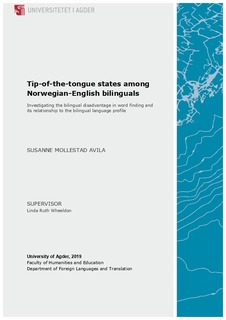| dc.description.abstract | The objective of this study was to investigatehow the bilingual disadvantage of word finding relates to the bilingual language profile. In two experiments 30 Norwegian-English bilinguals were presented with definitions of four different types of low frequent target words, to try to induce tip-of-the-tongue states: common noun cognates, common noun non-cognates, proper noun cognates, and proper noun non-cognates. If the participants experienced the feeling of knowing the target word, but had trouble finding it, they reported being in a tip-of-the-tongue state(TOT). One experiment was in English, the other in Norwegian. The participants also did a vocabulary test for each language as well as answering a comprehensive language experience and proficiency questionnaire (LEAP-Q) adapted from Marian and colleagues (2007). There was only a significant effect for the TOT proportions between the languages as a whole, where the TOT proportions in English were higher than in Norwegian. The factor analysis showed that increased TOT proportions related to factors such as proficiency, competition input from both English and Norwegian, and language competition in general (exposure, language switching and use). Additionally, it did not seem like there was a cognate facilitation effect on tip-of-the-tongue states among our group of bilinguals. Results were discussed in relation to the two hypotheses for the underlying mechanism of TOTs -the Weaker Links-and Competitionfor Selection Hypothesis. Even though there were also indications of support for the Weaker Links Hypothesis, the results from the regression analyses on TOT proportions seemed to gear most towards support for the competition account. The results of thestudy are not clear-cut and do not show many significant effects due to the low number of participants and their similar bilingual language profiles (they do not vary much). Also, the similarity between the English and Norwegian language plays a role here. But there are some interesting patterns worth discussing and looking at to possibly integrate into future research (e.g. patterns connected to access of phonology during TOT states). Abstract | nb_NO |

